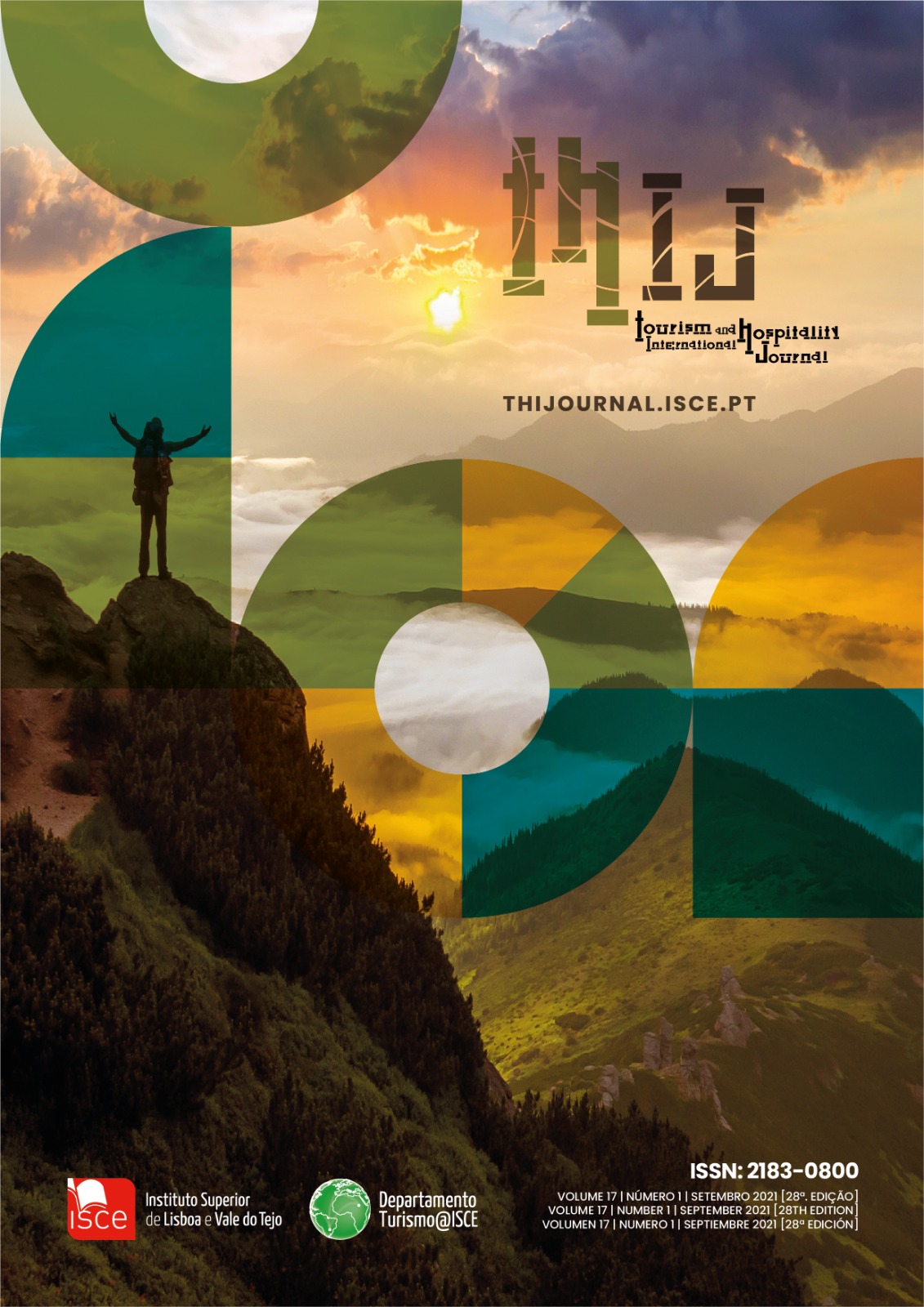Financial balance: comparison between four Portuguese thermal establishments
DOI:
https://doi.org/10.57883/thij17(1)2021.30914Keywords:
Thermalism, Health and wellness tourism, Financial analysis, Financial ratiosAbstract
Since ancient times, Man has known the powers of thermal waters in a relationship that has not been monotonous. In its evolution, the world began to include the two aspects of thermalism (classic and wellness) in the sphere of health and wellness tourism, which is considered, since 2006, as a strategic product for Portugal by Turismo de Portugal, IP. The aim of this study was to analyse the financial stability of four Portuguese thermal establishments, selected from a set of common characteristics which made them comparable. Using the most popular technique of financial analysis, the ratio method, the financial stability of the four Portuguese thermal establishments studied was tested and the research question of the study was: do these thermal establishments meet their short-term obligations and their financial commitments? The data of each company was obtained from the SABI database and the sector data, economic activity code 86905 – thermal activities, were obtained from Banco de Portugal’s website. Data was processed and analysed using the Microsoft Excel software. The study concluded that the four companies studied have different financial characteristics and in general, the Termas de São Pedro do Sul are closest to the sector average of the analysed ratios. Nevertheless, the majority of the companies have short-term financial stability, highly conditioned by the accounts receivable, and a strong dependency on debt in their financial structures
References
Banco de Portugal. (2020). Quadros do setor. Retirado de https://www.bportugal.pt/QS/qsweb/Dashboards, (acedido em 15/09/2020).
Bastos, C., Quintela, M. M., & de Matos, A. P. (2002). O novo aquilégio. Retirado de http://www.aguas.ics.ul.pt/index.htm.
Breia, A. F., Mata, M. N., & Pereira, V. M. (2014). Análise económica e financeira: aspetos teóricos e casos práticos. Lisboa: Letras e Conceitos, Lda.
Cantista, A. P. (2010). O termalismo em Portugal. Anales de Hidrología Médica 2008-2010, 3, 79-107.
Cavaco, C. (2008). Parte I – Turismo(s) de saúde e bem-estar. In C. L. Medeiros, & C. Cavaco (Eds.), Turismo de saúde e bem-estar: termas, spas termais e talassoterapia (pp. 22-128). Lisboa: CEPCEP – Centro de Estudos dos Povos e Culturas de Expressão Portuguesa, Universidade Católica Portuguesa.
Coutinho, C. P. (2011). Metodologia de investigação em ciências sociais e humanas: teoria e prática (2.ª ed.). Coimbra: Edições Almedina, S.A.
Cunha, J. (2013). A Análise Financeira como ferramenta de apoio à tomada de decisão. Estudo de Caso: Termalistur, E.E.M. - Termas de S. Pedro do Sul. Dissertação para a obtenção do grau de Mestre em Gestão de Unidades de Saúde, Universidade da Beira Interior, Faculdade de Ciências Sociais e Humanas, Covilhã.
Cunha, L. (2003). Perspectivas e tendências do turismo. Lisboa: Edições Universitárias Lusófonas.
Fernandes, C., Peguinho, C., Vieira, E., & Neiva, J. (2019). Análise financeira: teoria e prática (5.ª ed.). Lisboa: Edições Sílabo, Lda.
Gil, A. C. (2002). Como elaborar projetos de pesquisa (4.ª ed.). São Paulo, Brasil: Editora Atlas, S.A.
Leite, J. (2011, fevereiro 4). Termas de Monfortinho [post em blog]. Obtido de https://restosdecoleccao.blogspot.com/2011/02/termas-de-monfortinho.html.
Lima Santos, L., Gomes, C., Malheiros, C. and Lucas, A. (2021). Impact Factors on Portuguese Hotels’ Liquidity. Journal of Risk and Financial Management, 14: 144. https:// doi.org/10.3390/jrfm14040144.
Liu, C., O’Farrell, G., Wei, K., & Yao, L. (2013). Ratio analysis comparability between Chinese and Japanese firms. Journal of Asia Business Studies, 7(2), 185-199.
Mangorrinha, J. (2000). O lugar das Termas: Património e desenvolvimento regional As Estâncias Termais da Região Oeste. Livros Horizonte.
Mangorrinha, J. (2002). À volta das Termas: Viagens no espaço e no tempo. Caldas da Rainha: Livraria Nova Galáxia.
Martins, A. (2004). Introdução à análise financeira de empresas (2.ª ed.). Porto: Grupo Editorial Vida Económica.
Mourão, M. B. (1997). A água termal e as termas: uma história milenar. São Paulo, Brasil: ABINAM - Associação Brasileira das Indústrias de Água Mineral.
Neves, J. C. (2007). Análise financeira: técnicas fundamentais. Lisboa: Texto Editores, Lda.
Neves, J. C. (2012). Análise e relato financeiro: uma visão integrada de gestão (6.ª ed.). Alfragide: Texto Editores, Lda.
Pinto, H. G., Mangorrinha, J., & Serén, M. C. (2003). Álbum das Termas na colecção do Centro Português de Fotografia. Lisboa: Assírio & Alvim.
Queirós, M., Mota, C., Silva, E. S., Pereira, A., & Resende, M. (2020). Análise financeira de empresas. Porto: Quântica Editora - Conteúdos Especializados, Lda.
Quintela, M. M. (2008). Curar e recrear em termas portuguesas. In Termas de Portugal (pp. 9-22). Lisboa: Pixelprint – Edições, Imagem e Comunicação, Lda.
Ramos, A. R. C. C. V. (2005). O termalismo em Portugal: dos factores de obstrução à revitalização pela dimensão turística. Tese de Doutoramento. Aveiro, Portugal: Universidade de Aveiro.
Saias, L., Carvalho, R., & Amaral, M. C. (2006). Instrumentos fundamentais de gestão financeira (5.ª ed.). Lisboa: Universidade Católica Editora, Unipessoal, Lda.
Samo, A., & Murad, H. (2019). Impact of liquidity and financial leverage on firm’s profitability – an empirical analysis of the textile industry of Pakistan. Research Journal of Textile and Apparel, 23(4), 291-305.
Teixeira, S. C. (2013). O termalismo clássico na atualidade: o caso das Termas de Vizela. Dissertação de Mestrado em Lazer, Património e Desenvolvimento, Universidade de Coimbra, Faculdade de Letras, Coimbra.
Van Dijk, Bureau. (2020). SABI, Información Financiera de Empresas Españolas y Portuguesas. Available online: https://www.bvdinfo. com/en-gb/our-products/data/national/sabi#secondaryMenuAnchor1 (acedido em 12/10/2020).
Ventura, M. M. (2007). O estudo de caso como modalidade de pesquisa. Rev SOCERJ, 20 (5), 383-386.
Yin, R. K. (2001). Estudo de Caso: Planejamento e métodos (2ª ed.). Porto Alegre, Brasil: Bookman.
Downloads
Published
How to Cite
Issue
Section
License
Copyright (c) 2021 This work is licensed under a Creative Commons - Attribution 4.0 International (CC BY 4.0)

This work is licensed under a Creative Commons Attribution 4.0 International License.
This work is published under the Creative Commons Attribution 4.0 International License.






